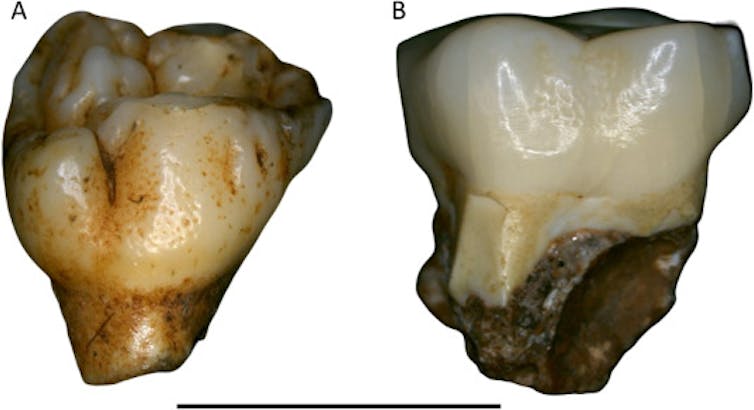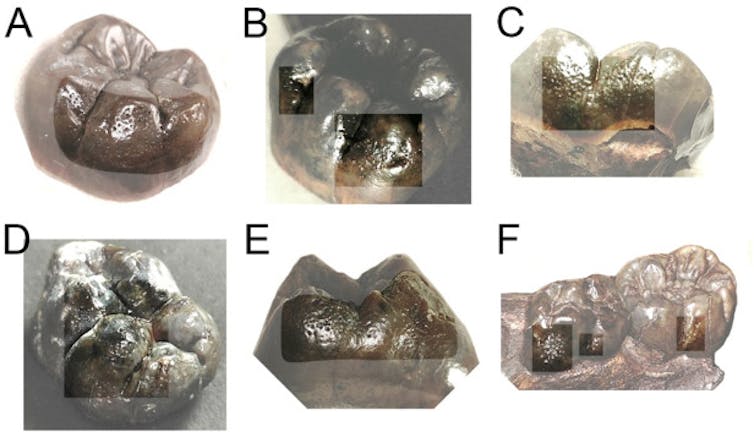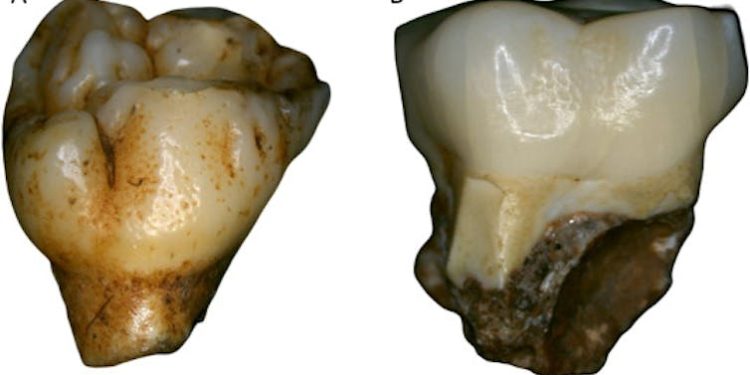The enamel that forms the outer layer of our teeth may seem an unlikely place to find clues on evolution. But that tells us more than you think of the relationships between our fossil ancestors and our loved ones.
In Our new studyPublished in the Journal of Human Evolution, we highlight a different aspect of enamel. In fact, we highlight its absence.
More specifically, we show that tiny shallow wells in fossil teeth may not be signs of malnutrition or illness. Instead, they may have surprising scalable meaning.
You may be wondering why it matters. Well, for people like me who try to understand how humans have evolved and how all our ancestors and parents were linked to each other, the teeth are very important. And having a new marker to search for fossil teeth could give us a new tool to help collect our family tree.
Uniform, circular and shallow
These pits were first identified in South African species Robustus paranthropusA close relative of our own genre Homo. They are very coherent in shape and size: uniform, circular and shallow.
Initially, we thought that the stands could be unique to P. Robustus. But our latest research shows that this type of bites also occurs in other Paranthropus species in East Africa. We even found it in some Australopithecus individuals, a genre that has been able to give birth to the two Homo And Paranthropus.

Towle et al. / Journal of Human Evolution
Enamel wells have generally been supposed to be defects resulting from stress such as disease or malnutrition during childhood. However, their remarkable coherence between species, time and geography suggest that these enamel pits can be something more interesting.
The bites are subtle, regularly spaced and often grouped in specific regions of the dental crown. It appears without any other sign of damage or anomaly.
Two million years of evolution
We have examined the fossil teeth of the hominins (humans and our closest parents) of the Ethiopia valley in Ethiopia, where we can see traces of more than two million years of human evolution, as well as comparisons with sites in southern Africa (Drimolen, Swartkrans and Kromdraai).
The OMO collection includes teeth attributed to Paranthropus,, Australopithecus And HomoThe three most recent and most famous homes of hominin. This allowed us to follow the revealing bites on different branches of our evolutionary tree.
What we found was unexpected. Uniform bites appear regularly in East and Southern Africa Paranthropusand also in the first East Africa Australopithecus Teeth dating back to around 3 million years. But among southern Africa Australopithecus and our own genre, HomoUniform bites were notably absent.
A defect … or just a line?
If the uniform bites were caused by stress or disease, we might expect it to correlate with the size of the teeth and the thickness of the enamel, and affect the front and rear teeth. But this is not the case.
In addition, stress -related defects generally form horizontal bands. They generally affect all the teeth developing at the time of stress, but this is not what we see with these bites.

Towle et al. / Journal of Human Evolution
We believe that this bite probably has a developmental and genetic origin. He may have emerged as a by-product changes in the way in which enamel has formed in these species. He could even have an unknown functional goal.
In any case, we suggest that these uniform circular tanks should be considered as a line rather than a defect.
A modern comparison
Additional support for the idea of a genetic origin comes from comparisons with a rare condition in humans today called an imperfecta improvisation, which affects the formation of enamel.
About one in 1,000 people today has an imperfect amelogenesis. On the other hand, the uniform bites that we have seen appear up to half of Paranthropus Individuals.
Although it probably has a genetic base, we argue that uniform bites are too common to be considered a harmful disorder. In addition, he persisted at similar frequencies for millions of years.
A new evolutionary marker
If this uniform bite really has a genetic origin, we can be able to use it to trace evolutionary relationships.
We already use subtle dental characteristics such as the thickness of the enamel, the shape of the cusp and wear models to help identify the species. Uniform bites can be an additional diagnostic tool.
For example, our results support the idea that Paranthropus is a “monophyletic group”, which means that all its species descend from a recent (relatively) recent ancestor, rather than evolving separately from different Australopithecus Taxons.
And we did not find these bites in the species of southern Africa Australopithecus AfricanusDespite a large sample of more than 500 teeth. However, he appears in the first OMOs Australopithecus specimens.
So maybe the bites could also help to identify where Paranthropus branched up on its own scalable path.
An intriguing case
A particularly intriguing case is Homo FloresiensisThe so-called species of “hobbit” of Indonesia. Based on published images, their teeth seem to show similar bites.
If it is confirmed, it could suggest an evolutionary history more closely linked as soon as possible Australopithecus species only for Homo. However, H. Floreensis Also shows potential skeletal and dental pathologies, so more research is necessary before drawing such conclusions.
Additional research is also necessary to fully understand the processes behind uniform bites before it can be systematically used in taxonomic work. But our research shows that it is probably a hereditary characteristic, that which is not found in the living primates studied to date, nor in our own genre Homo (rare cases of imperfect Amelogenesis aside).
As such, it offers a new fascinating tool to explore the evolutionary relationships between fossil hominins.


